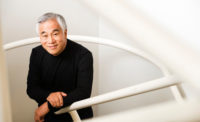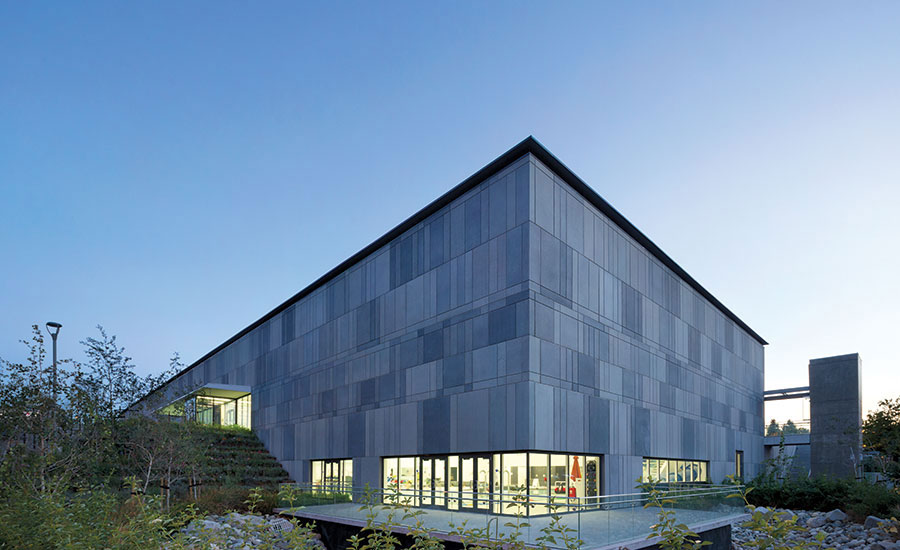Bing Thom and HCMA Design Two Pools in a Vancouver Suburb
Surrey, British Columbia

The undulating roof of HCMA’s aquatic center in Grandview Heights imbues it with visual drama while providing the needed height for diving platforms.
Photo © Ema Peter

The size and massing of HCMA’s aquatic center in Grandview Heights will make it the centerpiece of a new residential neighborhood to be developed on the surrounding farmland.
Photo © Ema Peter

The roller-coaster-like contours of the ceiling at Grandview Heights are made up of pairs of exceedingly slender curved glue laminated beams.
Photo © Ema Peter

The paired beams at Grandview Heights are supported at each end of the building by concrete buttresses and at midspan by V-shaped concrete columns that help articulate the entrance area.
Photo © Ema Peter

Images Courtesy HCMA

Images Courtesy HCMA

The afternoon sun seeps through a discreet row of skylights at Bing Thom’s Guildford Aquatic Centre, casting stripes of light upon the east wall.
Photo © Ema Peter

The precast aggregate-concrete panels that clad Bing Thom’s Guildford Aquatic Centre were tinted three different shades and fabricated in varying sizes to animate the facade.
Photo © Ema Peter

At Bing Thom’s Guildford Aquatic Centre, a pedestrian bridge runs over the pool, linking the main entrance and a secondary entrance.
Photo © Ema Peter

The prefabricated trusses at Bing Thom’s Guildford Aquatic Centre are made of laminated strand lumber painted with semitransparent white exterior-grade paint. At 10 feet high, 8 feet wide, and 95 feet long, each truss is large enough for a person to walk through to service the sprinklers, lighting, and mechanical systems hidden within.
Photo © Ema Peter

The laminated strand trusses for the Guildford pool were fabricated in a factory with services such as sprinklers, lighting, and mechanical systems already installed and then trucked to the site.
Photo courtesy StructureCraft

The laminated strand trusses for the Guildford pool were fabricated in a factory with services such as sprinklers, lighting, and mechanical systems already installed and then trucked to the site.
Photo courtesy StructureCraft

Image courtesy Bing Thom Architects

Image courtesy Bing Thom Architects














The Vancouver suburb of Surrey, British Columbia, is a city in high-minded transition. Newly aware of the financial, logistical, and environmental costs of its low-density, car-oriented sprawl, its municipal leaders have recently taken steps to transform the bedroom community into a better-defined and more fully equipped modern city. The harbinger was the construction of Surrey Central City: a shopping, office, and educational complex, designed by Bing Thom Architects (BTA), that created a sense of a downtown within Surrey. Now the city has two new public aquatic centers, each with a program that is the very epitome of urban vitality. Like the public library, the community swimming pool serves as a modern-day church of sorts, a gathering place empowered by North America’s dual obsessions with fitness and fun.
Community indoor swimming pools—natatoria, in the lingo—present logistical and technical challenges that require architectural ingenuity. First and foremost is height, in order to accommodate the high-divers and water-sliders, as well as to disperse the chlorine-saturated air. And for obvious reasons, the large interior space must have a long, clear span.
Near the city’s southern border, HCMA Architecture + Design has designed an aquatic center with an Olympic-size competition pool, diving platforms, a family-oriented leisure pool with water slide, hot tubs, a sauna, a steam room, and a weight room—all that in an area that until very recently has been sparsely populated agricultural land, but is slated to be developed into a vast residential neighborhood. HCMA has designed seven other aquatic centers in the Vancouver region. But the Grandview Heights commission posed a new kind of challenge. “We had a completely blank slate,” says Darryl Condon, HCMA principal. “We were asked to build the centerpiece of a community that doesn’t exist yet.”
HCMA’s answer to this problem was a roof that reads like a series of giant cresting waves from the outside and a billowing sheet of fabric from the inside. The undulating form, so dramatically evocative, was functionally driven. Devised with the help of structural engineers and timber specialists Fast + Epp, the roof is made of improbably long and thin ribbons of glue laminated wood. These slender elements (comprised of pairs of 4-inch-wide by 10-inch-deep beams tied together) are anchored at either end by post-tensioned concrete buttresses and a row of enormous canted V-shaped concrete columns at midspan. They perform in tension, much like the cables of a suspension bridge, notes Condon, allowing an area free of vertical supports for the 50-meter-long, 10-lane-wide pool. They also create catenary curves that reach a maximum height of 49 feet to clear the diving platforms, falling to 29 feet at the roof’s lowest points.
At the other end of Surrey, its northeastern corner, the Guildford Aquatic Centre bookends the evolving city. Designed by BTA in partnership with Shape Architecture, the Guildford pool expands an existing recreation center on the site. Like Grandview Heights, the Guildford natatorium contains a lap pool suitable for competition, plus a leisure pool, a water slide, and a “lazy river.” It too is visually defined by a roof with an innovative wood structure engineered by Fast + Epp and in keeping with British Columbia’s “wood first” policy, which promotes (though does not require) the use of engineered timber in new buildings; the material is also better suited than steel to the potentially corrosive pool environment.
But despite the two facilities’ similarities—both serve as community magnets and have innovative wood structures—there are striking differences. The Guildford facility’s architectural introversion, with its rectilinear, mostly opaque exterior of precast concrete panels, contrasts starkly with the exuberant volumes of its counterpart at Grandview Heights, enclosed in a curtain wall of glass and translucent polycarbonate.
Where Grandview’s ceiling ribs wow the visitor with their long and slender proportions, Guildford’s roof system impresses for different reasons. BTA’s 95-foot-long ceiling trusses—22 in all—evoke the underside of a train trestle, painted white but with the barely visible grain of the laminated strand timber showing through. The structure animates what would otherwise be a straightforward, shoebox-like volume.
Ingeniously, the trusses conceal infrastructure such as mechanical equipment and sprinklers—and, at 10 feet high and 8 feet wide, they are large enough for maintenance staff to walk inside to service these systems.
Linear fluorescent lighting is also hidden within the trusses. Along with subdued daylight that seeps in through small skylights at the roof’s perimeter, the indirect electric illumination helps create an almost meditative atmosphere.
This contemplative environment is reinforced by the site strategy. To mute the cacophony from an adjacent traffic-filled artery, the design team created a large berm that serves as an aural and visual barrier, giving the illusion that the addition is partly submerged in the ground.
Leading from the main entrance, the architects devised an interior catwalk-like bridge that runs through the building, over the pool—for modern flaneurs, gazing at the swimmers—and out the building’s other side into the parking lot. The bridge-walkers don’t have to pay admission: they can be commuters taking a shortcut to a nearby bus stop. The idea, says BTA principal Venelin Kokalov, the lead designer on Guildford, is to “project the future” by making pedestrians feel as welcome as possible.
What form that future development takes will be key to the full success of both projects. Like much of Surrey, the Guildford and Grandview Heights neighborhoods still require much more density and astute urban planning to be considered truly pedestrian-oriented. Fortunately, the city now has two more important anchor buildings that can help foster a lively, more walkable community—someday.
Grandview Heights Aquatic Centre
PeopleArchitect: HCMA Architecture + Design Personnel in architect's firm who should receive special credit: Principals Darryl Condon, Stuart Rothnie - Registered Architects Engineers: Structural Fast + Epp Consultants Landscape PFS Studio General contractor: EllisDon Photographer: Ema Peter 604-789-6339 Client: City of Surrey Gross square footage: 95,000 sq ft Total project cost: $55 million
|
ProductsStructural System Concrete and glulams (roof) Manufacturer of any structural components unique to this project: Best Choice Construction (RB) Ltd. - concrete and formwork Exterior Cladding Metal panels: Alucobond Translucent Glazing: CPI Daylighting Curtain wall: Columbia Glazing Systems Inc. Roofing Elastomeric: TPO Roofing by Firestone Interior Finishes Acoustical ceilings: Tectum - between the glulams in the natatorium and the Fitness Centre Cabinetwork and custom woodwork: Morinwood Mfg. Inc. Plastic laminate: Formica Floor and wall tile: Daltile (public area floors, pool tanks, change rooms) Raised flooring: IXL Glazed block (interior of natatorium) Special interior finishes unique to this project: IXL Glazed block (interior of natatorium) Lighting Downlights: GE Powerspot - Lights on the glulam ceiling in the natatorium Conveyance Elevators/escalators: Schindler Energy Add any additional building components or special equipment that made a significantcontribution to this project: Pool bulkheads - Natare |
Guildford Aquatic Centre
PeopleArchitect: BINGTHOM | ARCHITECTS Personnel in architect's firm who should receive special credit: Bing Thom, Michael Heeney, Venelin Kokalov, James Architect of record: Bing Thom Architects Inc Associate architect(s): Shape Architecture Engineers: Structural Fast + Epp Consultants Structural Fast + Epp Photographer: Building Photography Ema Peter Construction Photography Isaac Epp, of StructureCraft Builders Inc. Drawing and Diagrams Bing Thom Architects Inc Client: City of Surrey Gross square footage: 112,000 sq ft Total project cost: $38.6 million
|
ProductsStructural System Manufacturer of any structural components unique to this project: WOOD TRUSS SYSTEM The main feature of the natatorium is the prefabricated
Trusses StructureCraft (Glulam top and bottom chords, Laminated Strand Lumber (LSL) panels, pressure treated plywood decking) Exterior Cladding Precast concrete: Centura Building Systems Ltd. Glazing Glass: Glatech Glazing Contractors Ltd (Kawneer 1600 Classic series) Skylights: Glatech Glazing Contractors Ltd (Kawneer 2000 series) Interior Finishes Acoustical ceilings: ROCKFON Sonar acoustic panels Lighting Interior ambient lighting: LIGHT Early in the design process, it was determined that |
Guildford Aquatic Centre Truss Fabrication and Installation
Video courtesy StructureCraft

















